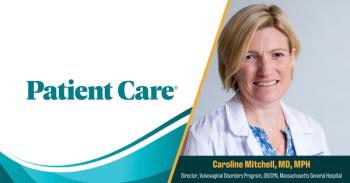
Update on Colorectal Screening
When to start screening-and which patients to screen? And with which screening method? Recommendations here from a panel of experts.
The prevalence of cancer is increasing: some kind of invasive cancer can be expected to develop in 1 of 3 people during their lifetime.
So said Carol A. Burke, MD, Director of the Center for Colon Polyp and Cancer Prevention at the Cleveland Clinic Foundation, Cleveland, at the recent American College of Gastroenterology (ACG) Annual Scientific Meeting and Postgraduate Course. Colorectal cancer is the third leading cancer in the US. Fortunately, over the past 25 years, deaths from this disease have decreased-a reflection in large part to increased screening. Identifying and modifying risk factors and treatment advances have played a lesser role in this decrease.
But can more be done? Colorectal cancer screening is increasing, Burke said, but the rate is still about 62%-well below what is should be. And in some sections of the population, the percentage of people who are screened is not nearly at that level. African Americans appear to have the lowest rate of screening-less than that of Caucasian, Hispanics, and Asian populations. In addition, Burke noted that colorectal cancer is more likely to be diagnosed at a late stage in African Americans, which may account for lower survival rates relative to non–African Americans.
Many screening options
Burke suggested the average patient’s risk mandates screening initiation at age 50; the ACG recommends that clinicians consider screening African Americans at age 45. And while the ACG shows preference toward colonoscopy as a screening method, Burke noted there are a number of options from which to choose. For instance, fecal occult blood testing (FOBT), which has high sensitivity, is a good option; if chosen, it should be performed annually. Another option, flexible sigmoidoscopy, should be performed every 5 years. Stool DNA testing and CT colonoscopy have been shown to be insufficient and should not be used, she added. If colonoscopy is the chosen screening method, it should be performed every 10 years. Burke noted there is some uncertainty about the age at which patients no longer need to be screened.
The number of options for screening presents a good news/ bad news scenario. Choices can be advantageous for both clinician and patient, but sometimes too many options can cause significant confusion, which may deter patients from participating in any screening. In one study, for example, researchers found that 13% of patients were confused by the array of options; women and patients who were uninsured had a higher likelihood of confusion.1 More importantly, the researchers found that patients who were confused were more likely to be nonadherent with screening recommendations.
Another study painted a slightly different picture. Here, primary care patients were randomized to receive FOBT, colonoscopy, or a choice of either modality.2 This study found the least adherence in the group randomized to receive colonoscopy; only 38% completed the screening. Patients in the group who were given the choice of both options had the highest adherence (69% completed screening); the group randomized to FOBT had a 57% adherence rate. Interestingly, Latino and Asian patients more often completed screening than African American patients.
Comparing modalities
Studies have shown that each of the modalities can be effective, useful tools. For instance, a randomized control trial of FOBT found such screening had a significant impact on mortality reduction.3 There are dietary and medical interactions, so patients need to make dietary and medication alterations before the exam. The fecal immunochemical test (FIT), which looks at antibody to globin, has good sensitivity, specificity, and patient adherence. In addition, it is not food-restrictive, which is a benefit.
Each modality has its pros and cons. For instance, a study that compared FIT with colonoscopy found higher adherence with FIT but noted that colonoscopy detected more non-advanced and advanced adenomas.4 The incidence of complications was also increased with colonoscopy.
Flexible sigmoidoscopy has fallen out of favor, Burke noted. It does help reduce mortality, she said, so if a patient prefers this method, Burke is comfortable with its use.
Screening colonoscopy has been very effective, Burke added. In a study from Poland, researchers followed 45,026 patients with a normal baseline for 5 years.5 During this time, there were 42 interval cancers. The researchers noted that colonoscopy detected 93% of these cancers.
Burke also discussed emerging technologies for screening and detection. Volatile organic compounds may hold promise, she said. Early data analysis from several studies of methylation only found 50% accuracy but 91% specificity.6 Currently, a Sept9 assay is available in Europe. Additional studies of the newer technologies are either in process or recently completed, so look for more data to come.
Hereditary Colon Cancer-Earlier Surveillance Required
Also of concern is hereditary colon cancer, which is associated with different surveillance strategies, surgical management, added Sapna Syngal, MD, MPH, Director of Gastroenterology at Dana-Farber/Brigham and Women’s Cancer Center at Harvard Medical School. Although most cancers (65% to 85%) are considered “sporadic” and associated with environmental, food, and other issues, about 10% to 20% are associated with familial history, she told conference attendees.
Hereditary colon cancer, which includes hereditary nonpolyposis colorectal cancer/Lynch syndrome, familial adenomatous polyposis (FAP), and harmartomatous polyposis syndromes, requires earlier surveillance of patients at risk, with colonoscopy recommended at 20 to 25 years of age and repeated every 1 to 2 years. Risk of other cancers (such as endometrial, ovarian, and pancreatic) is often associated with hereditary colon cancer, so patients should be monitored for these as well.
While familial history is especially important to help detect hereditary colon cancer, Syngal noted mutations can occur: FAP is associated with a 30% mutation rate. Thus, a patient can present with the disease without a family history; essentially, they become the first one in that family with the cancer, and the genetic risk can be transferred to future generations. However, the genetic component of these cancers holds good news for families, too. For instance, since it is autosomal recessive, if FAP is not inherited, the familial risk ends and the child (and subsequent generations) need not be concerned. Prenatal counseling is available.
IBD as a Risk Factor
Because inflammation is a risk factor for colorectal cancer, patients with inflammatory bowel disease are at increased risk for this cancer, reported David T. Rubin, MD, Professor of Medicine at the University of Chicago. In patients who have IBD for 8 to 10 years, screening should be initiated immediately and repeated every 6 months to 2 years. Since patients have differing risk factors, Rubin advocates a move toward “smart prevention,” which would tailor surveillance strategies based such risk factors as duration of illness, extent of illness, family history of colorectal cancer, presence of mass/strictures, and male sex.
Take-Home Thoughts
The bottom line? All speakers agreed that appropriate colorectal screening should be an important part of protecting your patient’s health. Screening saves lives.
References:
1. Jones RM, Vernon SW, Woolf SH. Is discussion of colorectal cancer screening options associated with heightened patient confusion? Cancer Epidemiol Biomarkers Prev. 2010;19:2821-2825.
2. Inadomi JM, Vijan S, Janz NK, et al. Adherence to colorectal cancer screening: a randomized clinical trial of competing strategies. Arch Intern Med. 2012;172:575-582.
3. Kumaravel V, Hayden SP, Hall GS, Burke CA. New fecal occult blood tests may improve adherence and mortality rates. Cleve Clin J Med. 2011;78:515-520.
4. Cole SR, Young GP, Esterman A, et al. A randomised trial of the impact of new faecal haemoglobin test technologies on population participation in screening for colorectal cancer. J Med Screen. 2003;10:117-122.
5. Kaminski MF, Regula J, Kraszewska E, et al. Quality indicators for colonoscopy and the risk of interval cancer. N Engl J Med. 2010;362:1795-1803.
6. Creeden J, Junker F, Vogel-Ziebolz S, Rex D. Serum tests for colorectal cancer screening. Mol Diagn Ther. 2011;15:129-141.
Additional Resources:
• AHRQ. National Guideline Clearing House: Screening for Colorectal Cancer.
• US Preventive Services Task Force. Screening for Colorectal Cancer. 2008.
Newsletter
Enhance your clinical practice with the Patient Care newsletter, offering the latest evidence-based guidelines, diagnostic insights, and treatment strategies for primary care physicians.































































































































































































































































































































